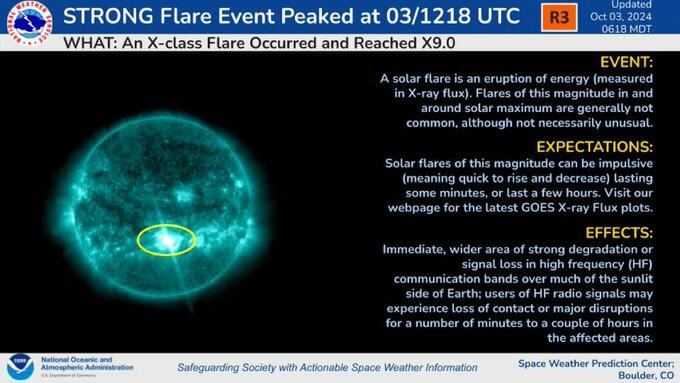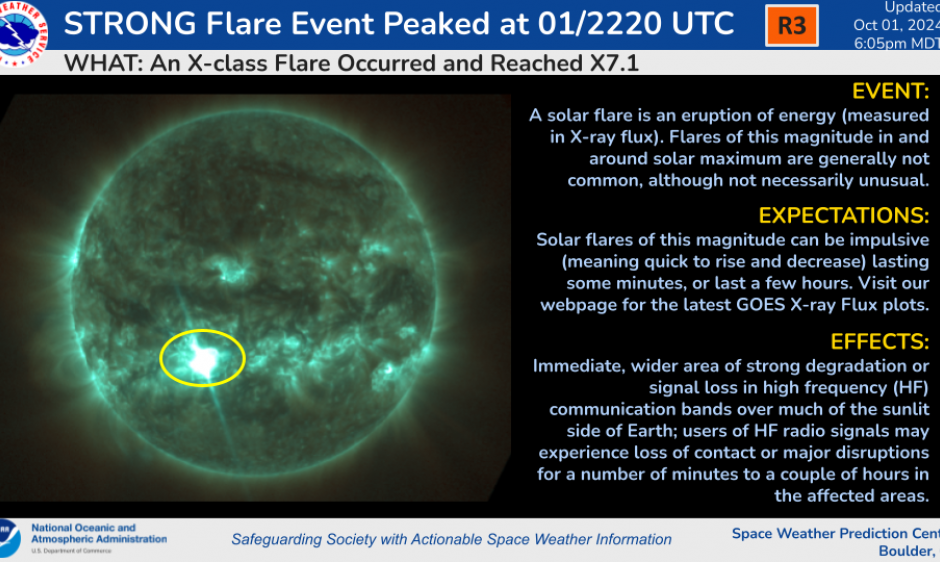Sun Ejects Earth-Directed X9.0-Class Solar Flare, Largest In Years
Update (1400 ET):
* * *
Update (1107ET):
The sun fired off a massive X9.05 solar flare from sunspot region 3842 toward Earth this morning.
Major X9.05 flare from sunspot region 3842
— SpaceWeatherLive (@_SpaceWeather_) October 3, 2024
Follow live on https://t.co/3Xxrvc3cpA pic.twitter.com/P9VcFbz9Ug
"Today's incredible X9.0-class solar flare, the most intense flare since 2017. An Earth-directed solar storm is highly likely, given the spot region is faced directly at Earth," Space Weather Watch wrote on X.
Today's incredible X9.0-class solar flare, the most intense flare since 2017. An Earth-directed solar storm is highly likely, given the spot region is faced directly at Earth.
— Space Weather Watch (@spacewxwatch) October 3, 2024
Stay with us for coverage of this historic event!#spaceweather @spacewxwatch pic.twitter.com/q9TTa53sGT
Still early days following the X9 solar flare from sunspot region 3842 which is the strongest solar flare of Solar Cycle 25 thus far but we do have some preliminary SOHO/LASCO coronagraph imagery from SEEDs right now. We see the beginning of a very nice halo coronal mass ejection… pic.twitter.com/tJsr6Tk6es
— SpaceWeatherLive (@_SpaceWeather_) October 3, 2024
Here's more from NOAA's Space Weather Prediction Center about the space weather event...
Meanwhile, on planet Earth, World War III risks are elevated. President Biden told reporters outside the White House that he was "discussing" with Israel about striking Iran's oil facilities.
We're reminded of the May 1967 solar storm that almost sparked nuclear war during the Cold War.
Here's more from Newsweek:
In May 1967, a solar storm brought the world to the brink of what could have been a nuclear war. With the sun now entering a period of increased activity as part of its 11-year solar cycle, experts have discussed whether or not we should be wary of a second such incident.
The world was in the grips of the Cold War in 1967 when the sun belched out one of the largest solar storms ever observed at the time, releasing a colossal radio burst that interfered with communication services here on Earth.
The United States military was immediately troubled by this radio interference on its radar system, which it interpreted as a deliberate jamming attempt by a foreign adversary. Such a move could have been considered a potential act of war, with the US operating a radar-based early-warning missile detection system to defend against the Soviet Union.
Luckily, a catastrophe never came to pass. The US Air Force had been expanding its space weather analysis capabilities and forecasters managed to intervene, convincing decision-makers that the sun was the likely culprit before any rash commands were issued—but not before bombers were primed to take off.
* * *
NOAA's Space Weather Prediction Center detected an X7.1 solar flare on Tuesday, the second strongest of Solar Cycle 25. It originated from Active Region 3842. The most powerful flare of the cycle, an X8.7, occurred earlier this year on May 14.
"This latest flare was observed by the GOES-16 satellite X-ray sensor (XRS) and peaked at 6:20 pm EDT (2220 UTC). The flare was impulsive in nature but was associated with some USAF solar radio observatory reports that may indicate a possible coronal mass ejection (CME) could be associated with the flare," SWPC wrote in a space weather update.
Wow! An X7.1-class solar flare — the second-biggest of Solar Cycle 25 — just launched off the Sun from sunspot AR3842.
— Matthew Cappucci (@MatthewCappucci) October 2, 2024
The next step is to wait to see if a CME, or coronal mass ejection, accompanied the flare. If so, it will probably be earth-directed. pic.twitter.com/fjoAxC5b3b
An update on space weather website SolarHam notes the solar flare was a "faint halo CME was associated with the X7.1 solar flare around AR 3842 Tuesday evening. Although not an overly energetic event, a passage past Earth will still be likely within 48-72 hours."
An X7.1 (R3) solar flare erupted from Region 3842 this evening - as seen in this animation (courtesy of jhelioviewer). This was the second strongest flare of Solar Cycle 25, only bested by an X8.7 flare on May 14th of this year. See https://t.co/MiukLmxbua for full story. pic.twitter.com/Qohhyk17DW
— NOAA Space Weather Prediction Center (@NWSSWPC) October 2, 2024
X user EarthSky wrote this morning, "Yesterday evening's giant X flare released a chunk of sun-stuff - a coronal mass ejection, or CME - toward Earth. Initial analysis says it should arrive October 5," adding, "It is a relatively fast but not a very big CME."
Yesterday evening's giant X flare released a chunk of sun-stuff - a coronal mass ejection, or CME - toward Earth. Initial analysis says it should arrive October 5. It is a relatively fast but not a very big CME.
— EarthSky (@earthskyscience) October 2, 2024
Read EarthSky's daily sun news: https://t.co/dVTIcoTvEg pic.twitter.com/2prs4z2sea
SPWC expects a minor to moderate solar storm by the end of this week or the weekend. In other words, auroras will be visible in certain areas.
As we've previously noted, the solar maximum has arrived.
Last year, we pointed out that Cycle 25 is expected to peak sometime in 2025.
It was noted that the 'first traces' of Solar Cycle 26 had been detected.
"First Traces" Of Solar Cycle 26 Detected On Sun https://t.co/8GTR5vJh1M
— zerohedge (@zerohedge) July 21, 2024
In early May, one of the most powerful solar storms in years blasted Earth. Fortunately, the digital economy held up, and Starlink's massive satellite constellation also survived.
Let's remember we've outlined just how fragile modern society has become in a solar maximum period of heightened Earth-facing space weather.
The Next Big Geomagnetic Storm Poses An Astronomical Risk To Modern Man
Solar Storms Present Danger Of Blackouts For Major East Coast Cities
Washington DC Most Vulnerable US City For Grid Failure During Geomagnetic Storm
Maybe the biggest threat to civilization is not the human-caused global warming narrative pushed by far-left corporate media outlets and progressive elected and unelected officials; instead, look to the sky. But then again, somehow, the climate alarmist will twist words and find a way to blame the sun-burping plasma on humans.
NEVER MISS THE NEWS THAT MATTERS MOST
ZEROHEDGE DIRECTLY TO YOUR INBOX
Receive a daily recap featuring a curated list of must-read stories.








